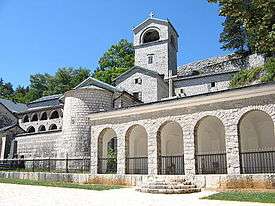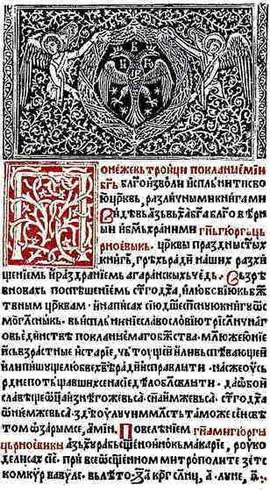Eastern Orthodoxy in Montenegro
Eastern Orthodoxy in Montenegro refers to adherents, religious communities, institutions and organizations of Eastern Orthodox Christianity in Montenegro. It is the largest Christian denomination in the country. According to the latest census of 2011, 446,858 citizens of Montenegro (72.07%) registered as Eastern Orthodox Christians. The majority of Eastern Orthodox people in Montenegro are adherents of the Serbian Orthodox Church. A minor percentage supports the noncanonical and unrecognized Montenegrin Orthodox Church.[1][2][3]
Serbian Orthodox Church in Montenegro


Four eparchies (dioceses) of the Serbian Orthodox Church cover the territory of Montenegro, two of them being entirely within its borders, and two partially:
- Metropolitanate of Montenegro and the Littoral, with seat in Cetinje,[4]
- Eparchy of Budimlja and Nikšić, with seat in Nikšić,[5]
- Eparchy of Mileševa, partially covers northwestern region of Montenegro and southwestern region of Serbia,
- Eparchy of Zahumlje and Herzegovina, also covers a small region of Sutorina in southwestern corner of Montenegro.
In 2006, the Bishops' Council of the Serbian Orthodox Church decided to form a regional Bishops' Council for Montenegro, consisted of bishops whose dioceses cover the territory of Montenegro. By the same decision, Metropolitan of Montenegro and the Littoral was appointed president of the regional Bishops' Council.[6]. The 17th-century Ostrog monastery is a religious landmark of Montenegro and the most popular pilgrimage site.[7]
Independent orthodox churches in Montenegro
In modern times, some independent groups and organizations emerged within the wider scope of Eastern Orthodoxy in Montenegro, challenging the traditional position of the canonical Serbian Orthodox Church in the country. Alternative religious movements are focused mainly on the creation of a separate and independent (autocephalous) Orthodox Church in Montenegro, receiving so far a limited support from the public.
Montenegrin Orthodox Church (1993)
In 1993, a group led by Antonije Abramović founded a separate religious organization, known as the Montenegrin Orthodox Church, receiving support from the Liberal Alliance of Montenegro, a minor political party that advocated the independence of Montenegro.[8] Antonije was proclaimed Metropolitan of Montenegro by his supporters, but his movement failed to gain any significant support. It remained unrecognized, and was labeled as noncanonical. In 1996, he was succeeded by Mihailo Dedeić who tried to reorganize MOC, hoping that state independence of Montenegro, achieved in 2006, would secure wider political support for his organization.[9] Those hopes were reinforced after the Moscow-Constantinople schism (2018), an event that caused great concerns among canonical Eastern Orthodox Churches.
Montenegrin Orthodox Church (2018)
In 2018, a group of priests of the Montenegrin Orthodox Church (MOC) split and formed an independent organization, claiming to represent genuine traditions of Montenegrin Orthodoxy.[10] This split was headed by Vladimir Lajović,[11] who became an archimandrite under the jurisdiction of the Orthodox Church of Italy (Italian: Chiesa Ortodossa d'Italia), a schism of the Orthodox Church in Italy, and another a noncanonical church body.[12] Creation of MOC-2018 presented a challenge for the Montenegrin Orthodox Church, since the emergence of the new organization received significant public attention.[13]
See also
- Christianity in Montenegro
- Serbian Orthodox monasteries in Montenegro
- List of Metropolitans of Montenegro
- Eparchies of the Serbian Orthodox Church
- Demographic history of Montenegro
- Serbs of Montenegro
References
- Cattaruzza & Michels 2005, p. 235-253.
- Morrison & Čagorović 2014, p. 151-170.
- Džankić 2016, p. 110–129.
- Official Pages of the Metropolitanate of Montenegro and the Littoral
- Official Pages of the Eparchy of Budimlja and Nikšić
- Communique of the Diocesan Council of the Orthodox Church in Montenegro (2010)
- Bataković 2005, p. 122.
- Buchenau 2014, p. 85.
- Džankić 2016, p. 120-121.
- Večernje novosti (2018): Raskol raskolnika: Crnogorska pravoslavna crkva se podelila u dve frakcije
- Archimandrite Father Vladimir Lajović
- Chiesa Ortodossa d' Italia: Organizzazione
- Sloboda (2019): Novi raskol raskolnika: Samozvani mitropolit nepostojeće italijanske crkve se odrekao Miraša
Sources
- Aleksov, Bojan (2014). "The Serbian Orthodox Church". Orthodox Christianity and Nationalism in Nineteenth-Century Southeastern Europe. Oxford: Oxford University Press. pp. 65–100.CS1 maint: ref=harv (link)
- Bataković, Dušan T., ed. (2005). Histoire du peuple serbe [History of the Serbian People] (in French). Lausanne: L’Age d’Homme.CS1 maint: ref=harv (link)
- Buchenau, Klaus (2014). "The Serbian Orthodox Church". Eastern Christianity and Politics in the Twenty-First Century. London-New York: Routledge. pp. 67–93.CS1 maint: ref=harv (link)
- Cattaruzza, Amaël; Michels, Patrick (2005). "Dualité orthodoxe au Monténégro". Balkanologie: Revue d'études pluridisciplinaires. 9 (1–2): 235–253.CS1 maint: ref=harv (link)
- Ćirković, Sima (2004). The Serbs. Malden: Blackwell Publishing.CS1 maint: ref=harv (link)
- Curta, Florin (2006). Southeastern Europe in the Middle Ages, 500–1250. Cambridge: Cambridge University Press.CS1 maint: ref=harv (link)
- Džankić, Jelena (2016). "Religion and Identity in Montenegro". Monasticism in Eastern Europe and the Former Soviet Republics. London-New York: Routledge. pp. 110–129.CS1 maint: ref=harv (link)
- Fine, John Van Antwerp Jr. (1994) [1987]. The Late Medieval Balkans: A Critical Survey from the Late Twelfth Century to the Ottoman Conquest. Ann Arbor, Michigan: University of Michigan Press.CS1 maint: ref=harv (link)
- Fotić, Aleksandar (2008). "Serbian Orthodox Church". Encyclopedia of the Ottoman Empire. New York: Infobase Publishing. pp. 519–520.CS1 maint: ref=harv (link)
- Ivić, Pavle, ed. (1995). The History of Serbian Culture. Edgware: Porthill Publishers.CS1 maint: ref=harv (link)
- Jelavich, Barbara (1983a). History of the Balkans: Eighteenth and Nineteenth Centuries. 1. Cambridge University Press.CS1 maint: ref=harv (link)
- Jelavich, Barbara (1983b). History of the Balkans: Twentieth Century. 2. Cambridge University Press.CS1 maint: ref=harv (link)
- Mileusnić, Slobodan, ed. (1989). Serbian Orthodox Church: Its past and present. 7. Belgrade: Serbian Orthodox Church.CS1 maint: ref=harv (link)
- Morrison, Kenneth (2009). Montenegro: A Modern History. London-New York: I.B.Tauris.CS1 maint: ref=harv (link)
- Morrison, Kenneth; Čagorović, Nebojša (2014). "The Political Dynamics of Intra-Orthodox Conflict in Montenegro". Politicization of Religion, the Power of State, Nation, and Faith: The Case of Former Yugoslavia and its Successor States. New York: Palgrave Macmillan. pp. 151–170.CS1 maint: ref=harv (link)
- Pavlovich, Paul (1989). The History of the Serbian Orthodox Church. Serbian Heritage Books.CS1 maint: ref=harv (link)
- Popović, Svetlana (2002). "The Serbian Episcopal sees in the thirteenth century". Старинар (51: 2001): 171–184.CS1 maint: ref=harv (link)
- Radić, Radmila (2007). "Serbian Christianity". The Blackwell Companion to Eastern Christianity. Malden: Blackwell Publishing. pp. 231–248.CS1 maint: ref=harv (link)
- Samardžić, Radovan; Duškov, Milan, eds. (1993). Serbs in European Civilization. Belgrade: Nova, Serbian Academy of Sciences and Arts, Institute for Balkan Studies.CS1 maint: ref=harv (link)
- Sotirović, Vladislav B. (2011). "The Serbian Patriarchate of Peć in the Ottoman Empire: The First Phase (1557–94)". 25 (2): 143–169. Cite journal requires
|journal=(help)CS1 maint: ref=harv (link) - Wachtel, Andrew B. (2004). "How to Use a Classic: Petar Petrović-Njegoš in the Twentieth Century". Ideologies and National Identities: The Case of Twentieth-Century Southeastern Europe. Budapest: Central European University Press. pp. 131–153.CS1 maint: ref=harv (link)
External links
| Wikimedia Commons has media related to Eastern Orthodoxy in Montenegro. |
- Official Pages of the Metropolitanate of Montenegro and the Littoral
- Official Pages of the Eparchy of Budimlja and Nikšić
- Statement of The Metropolitanate of Montenegro and the Coastlands (2009)
- Mass service held in Montenegro in defense of Serbian Church (2019)
- Freedom of Religion or Belief in Montenegro: Conclusions (2019)
